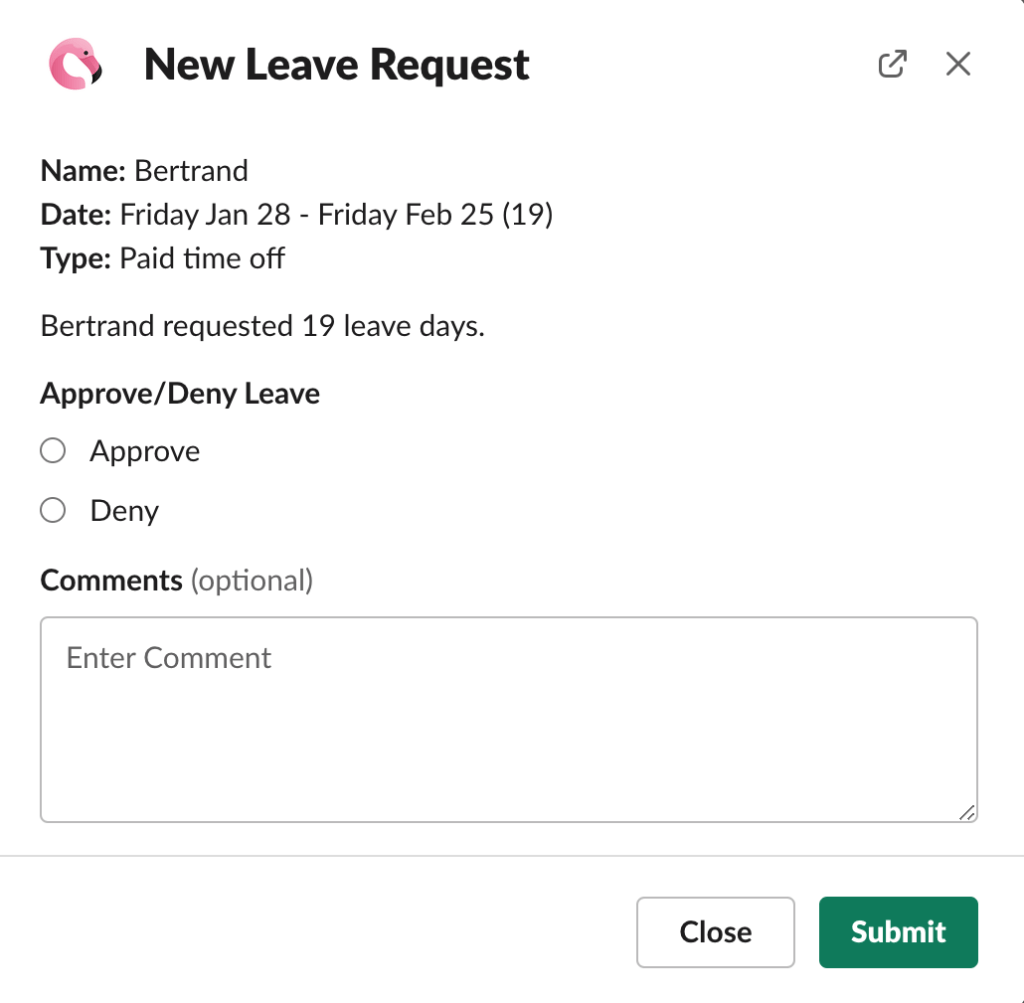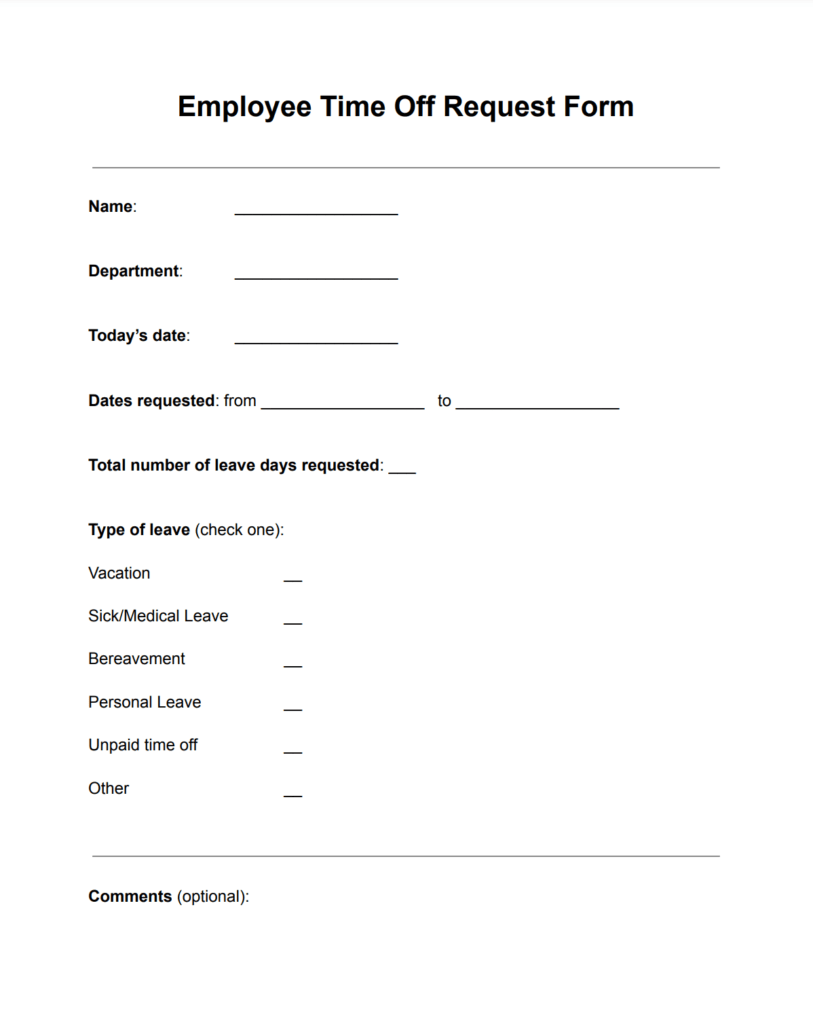April 16, 2024
HR Teams and Managers’ Guide to Leave Planning
An efficient leave planning process is vital if you want to allow your employees to take time off without cau...

If you’re a manager or a business owner, employee time off requests are not exciting. It may even give you a knot in your stomach when employees submit requests – one more problem you’ve got to solve.
But that doesn’t mean you can ignore, or discourage time off requests. Allowing your team members to take regular time off will help you build a more positive and productive work environment, by keeping them engaged, refreshed, and happy in their job.
The key to avoiding that feeling in the pit of your stomach when you see a time off request form is to build a rock-solid system for managing time off requests. That way, it doesn’t become another problem for you to deal with, as you’ve already got a process set up and ready to handle it.
Read on to learn how to set up a system for your business, and everything else you need to know about managing time off requests.
Is it really that important to build a system to handle time off requests?
A lot of business owners think not. Many make the process for requesting time off complex and difficult, to try and discourage people from taking leave. Others just don’t think a system is necessary. How hard can it be?
Either way, they don’t put stock into their leave management system. They don’t see it as a vital part of running a business, perhaps because an employee’s time off request is not going to lead to more revenue or new leads.
Here’s why that’s a mistake.
A lot of business owners or managers think of paid vacation time as a drain on their team, and on productivity, and an expense that they’d rather do without.
They don’t realize that paid time off can actually be an investment. You’re investing in happier, more talented and more productive employees, and an environment that is conducive to a higher standard of work.
If you look at the most sought-after employee benefits, there’s a common thread. People want more vacation time, or more flexibility, such as flexible time off, unlimited PTO, or an option to work from home. All to help them maintain a positive work-life balance, and a personal life outside of work.
Sufficient vacation time will make your staff happier, encourage them to stick with the company instead of jumping ship, and encourage new, talented employees to take your job offer over the next one.
The positivity from a team of happy employees is infectious. It leads to a more productive and more positive work environment as a whole. And the inverse is true – the negative energy in a workplace full of unhappy, overworked, burned out employees spreads like a virus.
Further Reading: Presenteeism is a poorly-understood condition, rife in modern workplaces, where the long-term productivity of an employee suffers because they are present too often. Click here to learn more, including how to prevent this in your workplace.
“Busywork” is the bane of productivity. These are the tasks (often administrative tasks) that are time-consuming, necessary to do, but don’t directly contribute to the growth of your business.
Managing time off requests falls under this category. You can’t ignore time off requests. But managing them – taking requests, filing them away, putting them into your schedule, collaborating with whichever departments need to know about the leave request – can take far too much of your time.
That’s why you need to create an efficient system to manage everything, saving your (or your HR team’s) time, to spend on tasks and projects with a higher return on time spent.
You should accept that employees will need to request time off at some point. Whether they get sick, have family matters to attend to, or simply take time off for themselves.
The business still needs to operate. Customers, clients or projects don’t go away. So the more efficiently you’re able to deal with time off requests, the better you can avoid disruptions, and damage to your bottom line.
Your time off request system starts with the set of rules for your team members to follow. These rules should be readily available in your employee handbook.
These rules should be clear and transparent, so that it’s easy for everyone involved to follow the same process each time an employee requests time off.
The exact set of rules in a time off request policy may be unique for your business. Each company has their own needs and specific considerations that may or may not apply. So take the following advice on board, but change it where necessary to fit your business.
It makes things difficult when you get time off requests coming from all sides. One in email, one in a Slack message, one from a face to face chat. Then all of a sudden, a carrier pigeon brings another time off request.
You should let employees know how to submit time off requests, and stick to it. That could be whatever works best for you and your team – whether it’s an email or paper request form, or using a specific app to manage time off requests.

Let employees know how far in advance they need to put in a leave request.
It’s a lot easier to plan for someone’s absence if you have time to prepare, rather than finding out the day before they plan to take time off.
For some types of leave, like sick leave, this won’t always be possible. But apply it where possible, such as vacation days.
How far in advance is up to you. Consider how long you’ll need to plan to replace this person for the time they’ll be away. It could mean you need two weeks’ notice, or two days’ notice.
The length of their leave may also make a difference. For example, you might require a month’s notice for time off requests over 2 weeks, but just a week’s notice for anything less.
Do you have rules for how often people can ask for leave? For example, can someone take every second Friday off, or do you want to limit it to a certain number of leave requests over a certain time period?
Your leave policy, and the total number of vacation days available to employees may effectively handle this for you. But consider whether this is a necessary stipulation to make.
You can include different types of leave in your time off policy. For example, other than vacation and sick leave, you might have anything from bereavement, to paternity and maternity, to military leave covered in your policy.
However – and it’s a big however – you should not require employees to give a reason when requesting their vacation days. Have other rules in place – such as how to request, how much notice they need to give – and if these rules are followed, that should be all you need to know.
Don’t make your employees feel they need a good reason to take the vacation days that come as part of their employment contract.
There may be particularly busy times of the year where you need all hands on deck, and can’t afford to have anyone on leave.
This could be the end of the financial year. For a retail business, it could be the lead up to Christmas.
If there are times when employee time off is not allowed, make sure everyone knows. And stick to it. It’s not fair if you bend the rules for some people, but not others.
There are also situations where multiple people ask for leave at the same time, which could put you in a bind.
One person going on leave may be easy to schedule for. But five people, and it’s not so easy anymore.
The size of your business or team will dictate how many people you can allow on leave at the same time. You might not be able to put a clear number on it – but if you can, it will make denying overlapping requests much easier.
Continuing on the last point, you should have a plan for what to do with multiple requests for leave at the same time.
If you approve some time off requests and deny others, it can easily lead to accusations of unfairness or favoritism. So having your process written down and part of your policy is a must.
The best way is usually first-come, first-served. Whoever requests time off first gets priority. This is the most iron-clad way to avoid accusations of bias.
For this, you really need a way to timestamp each leave request, so you have clear proof who asked first, in the case that multiple people ask for time off in quick succession. This is where a leave management software helps out.
If you choose to go by any other criteria – such as seniority, role, number of prior requests or managerial discretion – make this clear beforehand. But think long and hard about whether this is worth the potential negative sentiment from employees who have their requests denied.
Flamingo streamlines leave management, letting you spend less time managing paid time off and more time growing your business
If you’ve put rules in place for how your employees should ask for time off, you’re halfway there already.
But there’s still more to take into account when setting up how you manage time off requests. Here are some tips.
It’s important to bring everything together in the same place.
It starts by asking employees to request time off from the same place, every time. And ideally, you’ll be able to manage these requests – review, approve or deny, and add to your vacation calendar – in the same place.
This is one of the benefits of using a tool like Flamingo. You’ll manage every part of your leave management system in one app, resulting in significant time savings, and fewer errors where requests, or responses to requests, get lost in the shuffle of a thousand different tools.
It’s best practice to respond to employees’ requests as soon as possible, for a number of reasons.
First, it gives you as much time as possible to plan for the employee’s absence.
Second, the person who gave the request likely needs confirmation in order to make plans for their vacation. The employee will be a lot happier if they get a quick answer, rather than being held hostage for days wondering if it’s safe to prepare yet.
And if you end up needing to deny an employee time off request, it will go down a lot smoother if you respond quickly.
Imagine you requested time off, didn’t hear back for two weeks, and when you did, you were told it was declined. You wouldn’t be happy, and neither will your staff.
You might want to batch these tasks together, rather than dropping everything each time someone requests time off. That’s fair – but you can’t afford to wait too long. Set aside a time once a day to check for leave requests, and handle them straight away.
The best way to ensure every time off request contains everything you need to process the request quickly is to have team members use the same form every time.
This should have the basic “need to know” information – the employee’s name, request dates, and the type of leave (e.g. vacation, sick leave, unpaid leave).
You can also add an optional field for any comments, where they can mention why they’re asking for leave. But make sure this is optional.
It’s even better if this form is digital, and carries a digital footprint that shows exactly when it was submitted.
Check out this template of a simple time off request form:

Get the template for yourself here:
Time off request form template
Small team? This post shows you how to set up a simple vacation tracker in Google Sheets, along with a template to help you get started.
It’s likely that, at some point, you’ll need to deny someone’s time off request.
This can be a difficult subject, and handled poorly, can be met with some negativity from the employee. So it’s important to deal with it the right way when you need to deny a request.
First of all, it’s going to be a lot easier if you respond to the request quickly. As we mentioned a little earlier, no one wants to hear two weeks after they submit a time off request that it’s actually been declined, and they need to cancel their plans.
When you deny the request, point to the part of your policy that explains why – such as there being too many people on leave already. Again, this is why it’s vital to have a clear policy with clear rules for how time off requests are to be handled.
You may also want to negotiate with the employee for an alternative solution. For example, you might propose another date, when it’s more suitable for them to take time off. Or you can encourage them to find someone to find a replacement during this time, or discuss whether they’ll be allowed to take leave if they finish a particular project or set of tasks earlier.
This will usually go over better with the employee than just a firm “no”, and lets them know you genuinely care about them getting to take their time off.
On the surface, managing time off requests might seem like a minor task. Compared to other elements of running a business – such as acquiring leads, product design, marketing – it does not feel important.
But if your business is more than a solo operation, you rely on your employees to keep the business running day in and day out. So you want to invest in making life easier for your staff members.
Making it easy and stress-free for them to take time off contributes to this. It also signals to your staff that you care about them, not just what they can do for you.
That’s going to lead them to work harder and put more effort into producing at a higher standard, because you’re playing your part in a positive, two-way relationship.
Your time off request process also saves a ton of time, and makes it easier to schedule replacements for staff who go on leave.
If your team is on Slack, Flamingo is the best option to manage your time off request process.
Flamingo lets your team request leave directly in Slack. The manager in charge of reviewing this request will get a notification in Slack, where they can approve or deny the time off request, again without leaving the platform.
Flamingo is customizable to fit the needs of your team, and comes with a web app that makes navigating your vacation calendar a breeze.
It’s free to try, so there’s no risk for you to see how Flamingo makes your team run more efficiently.
Flamingo makes managing your team’s paid time off a breeze.